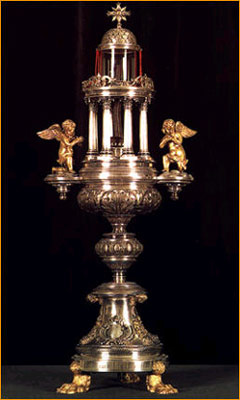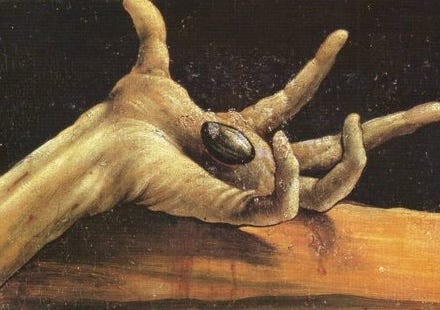This is the second part of a deep dive (about 4,000 words) covering the nails of the crucifixion. Part I examines the Biblical, extra-Biblical, and artistic evidence for Jesus being nailed to the Cross. Part II covers the relics.
The Archaeological Evidence
The issue of nails in crucifixion was given some archaeological evidence in 1968, with the discovery of three tombs in an area called Givʿat ha-Mivtar (or Ras el-Masaref). Excavated by V. Tzaferis, of the Israeli Department of Antiquities and Museums, Tomb I included an ossuary for a young man named Yehohanan ben ḤGQWL (Yehoḥanan son of Hagkol).
Inside, were the bones of an adult male, age 24-28, and a child. The adult’s tibiae and fibulae had been intentionally broken, and both calcanei (heel bones) were pierced by a nail that was still in place. Following forensic examination of the remains, Tzaferis called it “undoubtedly a case of crucifixion.” Based on other evidence, he speculated that it was either a rebel executed during the census revolt of 7AD, or some other first century crucifixion.
Dr. N. Haas, of the department of anatomy of the Hebrew University and Hadassah Medical School, concluded that the nail had been driven through a small plaque of acacia or pistacia wood, then through the heels, through the upright of the cross, and then bent on the opposite side of the upright. Haas wrote:
The feet were joined almost parallel, both transfixed by the same nail at the heels, with the legs adjacent; the knees were doubled, the right one overlapping the left; the trunk was contorted; the upper limbs were stretched out, each stabbed by a nail in the forearm. A study of the nail itself, and of the situation of the calcanean bones between the head and the top of this nail, shows that the feet had not been securely fastened to the cross. This assumption requires the addition of the traditional “sedecula” … intended to provide a secure seating for the buttocks of the victim, to prevent collapse and to prolong agony. (From Israeli Exploration Journal 20, quoted in Joseph A. Fitzmyer, To Advance the Gospel: New Testament Studies)
Haas noted that the fracture of the right tibia was by a “single, strong blow”: ““The percussion, passing the already crushed right calf bones, was a harsh and severing blow for the left ones, attached as they were to the sharp-edged wooden cross.”
The damage to the body was such that the nail could not be withdrawn, requiring the amputation of the feet.
The importance of this find should be obvious, since it adds concrete archaeological and forensic evidence to written accounts for first century Roman crucifixion in Palestine.
It also gives us an actual nail that was used in a crucifixion: an iron carpenter's nail about 16 centimeters long with four sides.
The Relics
There are perhaps 36 nails in various Churches with claims to be the real deal. Obviously, they can't all be, but it's possible that they're not all blatant frauds either. There is a middle ground.
There is also the question of whether Helena did, in fact, recover the genuine nails in the Holy Land, or whether helpful locals simply passed off some old nails as the genuine article. That some of the nails are similar to the Yehohanan is suggestive but not conclusive. I think we can determine, however, that the nails in Rome, Siena, and Milan have fair claims to being the nails of Helena. Whether those are in fact the nails of the crucifixion is more than we can say for sure.
The nail of Yehohanan gives us hard evidence, and combined with other factors allows the elimination of certain nails. For example, a nail in Notre Dame is too short, while the one kept in Trier is not old enough and also too short. Others kept in Toul, Cologne, and Essene have weak claims to authenticity.
It’s important to note that these may be partial or third class relics. They may contain pieces of the real nails or have been touched to a real nail, and when this detail was lost to history they became “genuine nails.” Someone could have scraped filings from a genuine nail and forged it together into a complete imitation nail using contemporary iron.
The Holy Cross Nail (Rome)
The first place we must turn to is the Basilica of the Holy Cross in Jerusalem (Basilica di Santa Croce in Gerusalemme) in Rome, consecrated in 325 with a floor that included soil from the Holy Land. Hence, the name “in Jerusalem” refers not to the Cross, but to the Basilica itself, which is “in Jerusalem” because it sits on soil from Jerusalem. According to tradition, the Basilica was built around St. Helena’s personal palace chapel, which itself had been built on the former site of a temple to Sol Invictus (the Invincible Son). It has been restored and expanded many times over the centuries. A chapel houses various relics of the crucifixion.
The Holy Cross nail is similar in shape to the Yehohanan nail, but, at 11.5cm, significantly shorter. This appears to be because the original head and the point broke off. Other pieces were probably removed over the years as relics. Since some of the nails which claim to be real match the Holy Cross nail, it’s quite possible filings or whole pieces of the original were integrated into replicas. This would mean that some of the many nails may still lay claim to being relics even if they include other material, since in relics a portion stands for the whole.
Given the continuous history of the Basilica, connection to Helena, and its current size and shape, the Holy Cross nail has the best claim to being genuine. That is, if Helena did indeed find the relics of the crucifixion and return with them to Rome, this is where they should be, and they appear to be the right material, shape, and, size. Indeed, the width of the Yehonanan nail and the Holy cross nail (0.9cm) are almost identical.
The Siena Nail
This leaves the two Constantine nails to consider. They were held for many centuries in the Byzantine imperial treasury. In 1354 one was purchased by a Venetian merchant, who sought the opinion of the papal nuncio in Constantinople. Confirmation came from the empress Irene Asanina, who had sold it after the abdication of her husband, Emperor John VI. Since selling relics was forbidden, the nail was signed over as a “gift” to the Santa Maria della Scala Hospital in Siena. It arrived in Siena in procession in 1359, and the Manto Chapel was eventually built to house it.
Is it genuine? Again, the chain of custody is strong. The nail itself is similar in size and shape to both the Holy Cross nail and the nail of Yehohanan, and that’s as much as we can really say.
The Bridle Nail (Milan)
Nails were said to have been forged into a bridle and a helmet for Constantine. Writing in the 5th century, Theodoret of Cyrus wrote that this was a single nail, spit in half, with one part embedded in the helmet, and another melted to be made into a bridle.
Today, Milan and Carpentras both claim the bridle. Milan’s claim is stronger, because it was where emperor Theodosius I died in 395, leaving his imperial insignia to St. Ambrose.
The piece of twisted metal could certainly be a piece of a horse’s bridle. It resided continually in the Church of St. Thecla until 1389, when it was moved in procession to the Cathedral of Milan, where it is kept today. When a plague hit the city in 1567, St. Charles Borromeo processed barefoot through the street with a cross and the reliquary of the nail. The end of the plague was attributed to this act.
To celebrate the deliverance, a special canopied lift painted to look like a cloud and festooned with angels, was created. Through an ingenious serious of ropes and pulleys, the basket is raised to the cathedral vault 45 meters above, where the reliquary of the nail is kept most of the year.
Every year for the past 400 years it is brought down in the annual Rite of the Nivola. This was on May 3rd (the feast of the Invention of the Holy Cross), until the holy day was dropped from the calendar. It now takes place on September 14th.
Locals claim Leonardo designed the lift. He didn’t.
As for the helmet of Constantine, history is silent.
Addendum—Nails: In the Palm or the Wrist?
The location of the nails is a controversial point, with the testimony of visionaries, stigmatics, and centuries of art weighed against claims of forensic science and a very important relic. Short version: Jesus is traditionally depicted with nails in his palms, but this would not have supported his weight and the nails must have been in his wrist. The controversy is unresolved, although I have my own thoughts.
The modern doubts about the palms took shape with the publication of Pierre Barbet’s A Doctor at Calvary in 1950. A surgeon, Dr. Barbet conducted experiments that showed that nails through the center of the palm would not bear the weight of a human body without tearing. He suggested that the nail would have been driven through a gap at the heel of the hand surrounded by the hamate, capitate, triquetral and lunate bones, and known as Destot’s space after its discoverer, Etienne Destot.
This conclusion was challenged on two grounds. First, it’s possible or even probable that the arms were tied to the cross and the nails simply added as an extra brace or to cause more pain.
Second, Frederick Zugibe, a medical examiner, claims that the palm would have worked if the nails were driven at an angle, exiting at the wrist. He published these conclusions in The Cross and the Shroud: A Medical Inquiry into the Crucifixion (1998, revised 2005).
Both authors, however, agree that the Shroud of Turin provides compelling evidence that the nails were not driven straight through the palm and out the back of the hand. The blood flow on the shroud testifies to an exit wound in the wrist. I believe the shroud is genuine, but whether the nail entered directly through the wrist, through the palm and downward through the wrist, or through Destot’s space is undetermined. I’m included to agree with Barbet, however.
The Nails of the Crucifixion: Part I
This is the first part of a deep dive (about 4,000 words) covering the nails of the crucifixion. Part I examines the Biblical, extra-Biblical, and artistic evidence for Jesus being nailed to the Cross. Part II will cover the relics.
Note
I am adding personal notes to end of my weekly newsletters for An Owl Among the Ruins, where I publish devotional writing. If that sort of thing interests you, clicketh thou below.













That 1968 discovery in Israel of heelbones transfixed by a Roman nail is not unique! Since my 2016 ordination, additional heelbones with nails in them have been found in Roman cemeteries in Italy in 2018 and most recently in England in 2021.